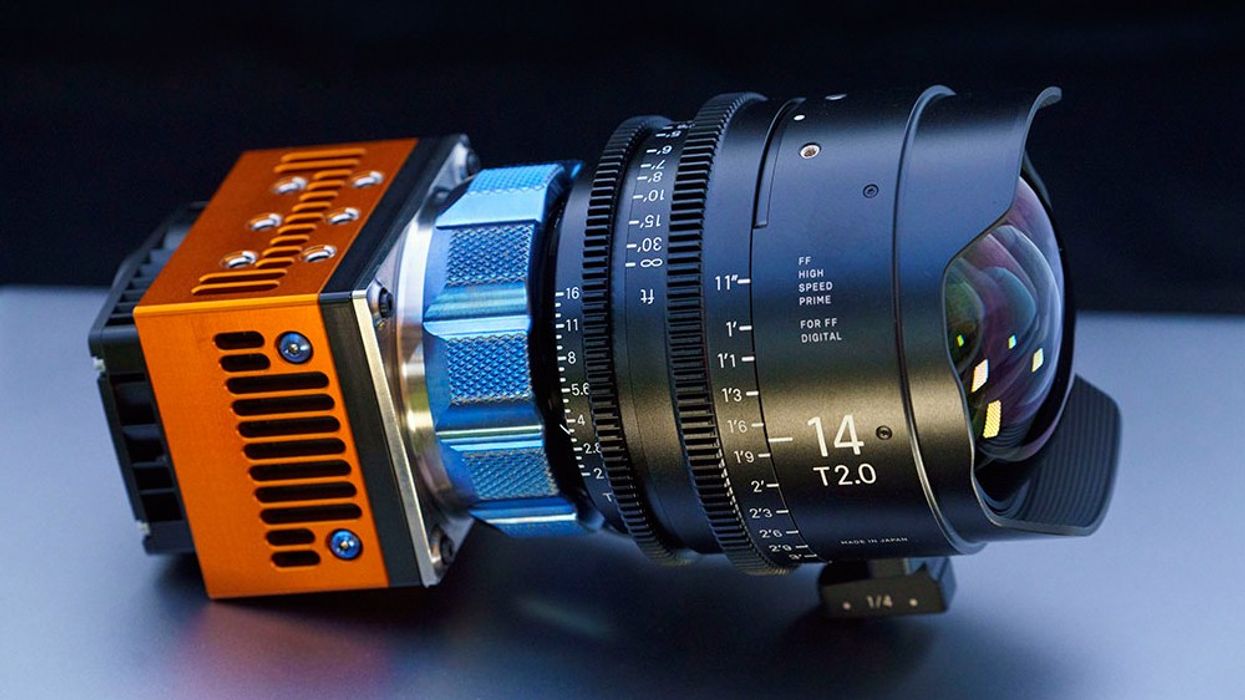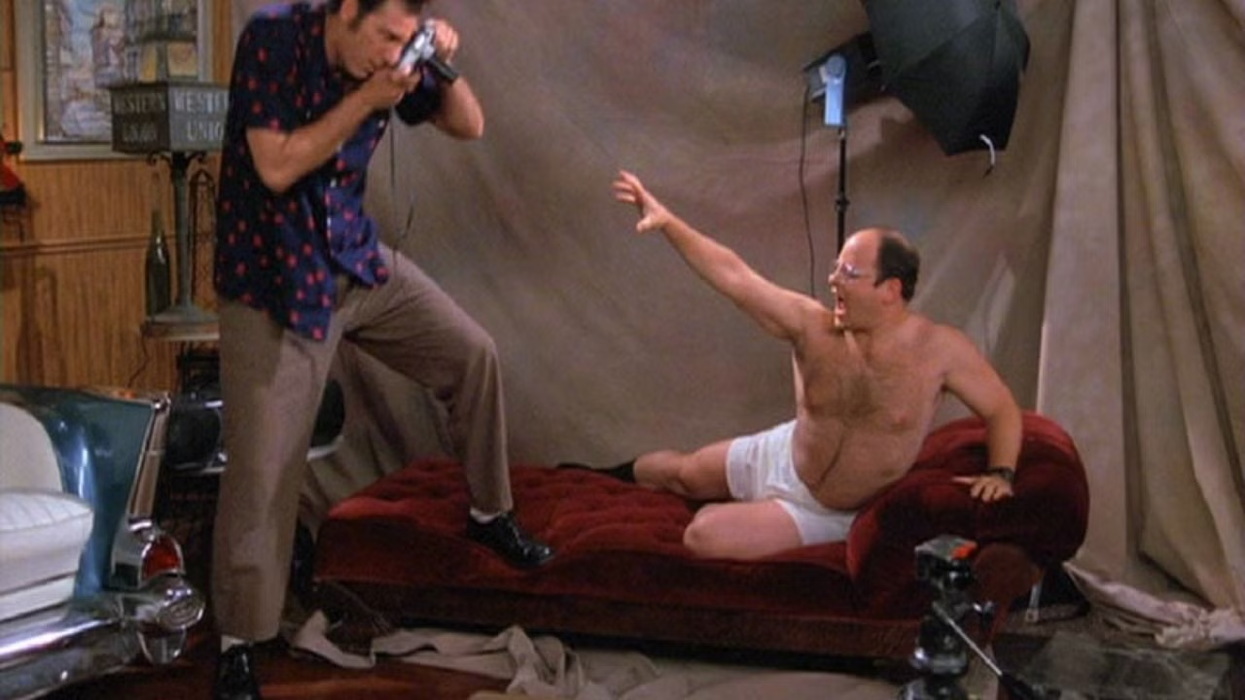Meet the 65 Megapixel Cinema Camera Gunning for IMAX
The 9x7 aims to democratize Giant Screen filmmaking.

Pawel Achtel, a cinematographer by trade, has roots in Australia, so it's only fitting that he found a passion for underwater photography. When the technology he sought out to improve his craft wasn't available, he decided to make it. Teaming up with Mark Horstman in 2013, they combined lens technology and titanium housing to bring ultra high definition underwater images to the big screen.
Achtel has since moved his gallantry on land with the development of the 9x7, a digital cinema camera designed specifically for VFX, VR, Giant Screen, and IMAX productions. The camera touts an APS-H sensor with 65 megapixels and records uncompressed RAW footage up to 10GB/s using a true global shutter capable of frame rates up to 70fps at full resolution.
While its price tag of about $145,000 ($200K AUD) might seem steep, when comparing to a renting a IMAX camera combined with buying and processing 15-perf 70mm, it can be a bargain. No Film School reached out to Achtel to learn more about this IMAX alternative. Here's what he had to say:
No Film School: For those who don’t know about Achtel gear, can you share how you got into designing tech for filmmakers?
Pawel Achtel: Most often it was my own need as a cinematographer and filmmaker. I always tried to improve my cinematography and lift it to a new level and, more often than not, this meant creating better tools.
NFS: Those needs were mostly in underwater equipment from the start, right?
Achtel: Yes. Having a Master’s Degree in Engineering and a scientific background, I felt I could design these better than what was commercially available.
Continually improving my designs, I eventually manage to achieve recognition. When we entered our new range of housings into Innovation Awards at NAB Show 2013, the winner was not the Canon EOS C300, Canon EOS C500, Blackmagic Cinema, or the Sony NEX-FS700, who were all finalists, but it was our DeepX and 3Deep underwater housings.
More recently, our patented underwater 3D beam-splitter was used extensively on James Cameron’s latest Avatar sequels, in New Zealand, prompting the legendary Hollywood director to write that the results were the best underwater 3D images he’d ever seen. By far.
NFS: That must have been a great feeling edging out all the big name camera manufacturers. What was the inspiration and concept behind the 9x7?
Achtel: Whilst we have experienced a fast pace of technological improvement in the quality of mainstream cinema, we have not seen the same rate of technological advancement in Giant Screen and IMAX cinemas. In fact, we have seen some IMAX screens reduced in size and many recent films have lower resolution and are not as sharp leaving some of the audiences wanting more. With these changes have we lost the grandeur and high ground that those cinemas once stood for?

NFS: That’s a good question. Do you think part of the answer is creating an alternative to IMAX cameras to get it into more filmmakers' hands?
Achtel: Giant Screen and IMAX cinema has been my focus for the past 20 years. This medium is different from traditional cinema and television in many ways. One such difference is the aspect ratio, 4:3, meaning most digital footage needs to be either cropped or vertically extended in post-production. Second is the resolution, where 8K is an absolute minimum and even then it is not enough for some of the largest screens.
Those two requirements make all currently available digital cinema cameras poorly fit for purpose. The only solution was to create a camera specifically designed for the Giant Screen filmmakers. A camera that would give the cinematographers the confidence that each and every frame conveys powerful emotions, perfect skin tones, crisp detail, and the legendary sweeping grandeur of large format cinematography. A modern replacement for 15-perf 70mm IMAX film.
NFS: The sensor on the 9x7 is very large. Can you talk about what makes it unique?
Achtel: The sensor is the very latest design that has only become available this year. It is produced in low quantities in different “grades”. Obviously, we incorporate the highest grade only. It has several unique features that made it particularly suitable for this type of camera.
One of such features is overlapped readout, meaning you can read the frame off of the sensor’s FPGA while acquiring the next frame. This allows, for example, full speed MOCO triggered acquisition. This is not possible with most other cameras as they can only run at half the speed. Another was very low noise and high sensitivity, exceeding that of cameras that have much larger sensors.
The high-performance CFA design allows us to obtain a wide color gamut with precise reproduction of saturated colors again, better than most high-end digital cinema cameras currently on the market.
NFS: The 9x7 can record RAW footage up to 10GB/s. Can you share how it records its RAW data?
Achtel: The 9x7 actually records proprietary RAW files, which are converted to standard DNG files in a post-process. The post-process is when metadata “enrichment” happens, the black shading and flat field correction are applied, and most importantly, where camera color profile is attached. So, nothing is “backed-in”, yet, the delivery format is in industry-standard DNG format. If required, the conversion process can be re-applied and, for example, black shading can be done after the shot was taken. Most other cameras can’t do that.
This conversion process can be performed in-camera or on a work station and usually takes only a little bit longer than real-time.
NFS: Can you explain how massive 10GB/s of data is and what it means for image quality?
Achtel: When it comes to IMAX and Giant Screen, it is the height of the image that matters because it is in 4:3 aspect ratio and, in the case of full-dome, 1:1 aspect ratio. This means that, if you film with, say, an 8K camera like RED Monstro, you are effectively filming 5.7K x 4K (23 Megapixels). The 9x7 has almost 300% more pixels than this, each of which does not undergo heavy compression and therefore can preserve a minute detail far better. The result is an order of a magnitude more detailed picture.
10 GB/s is the sustained bandwidth of the media. Practically the camera head delivers about 6 GB/s to the recording module, which is further “enriched” with additional data during the recording process.
Consider it as a “thick negative” of sensor data. This data can be debayered 1:1 (1 photosite for 1 pixel) like most of the cameras do. But, if there is sufficient, "clean" and compression-free, artifact-free sensor data, you can also debayer it 1:4 (one photosite to four pixels) and this is exactly what we do to achieve 18.7K x 14K (260 Megapixels).
Our testing shows that, pixel-for-pixel, the results are as good as or better than that from other high-end cameras debayering compressed data at 1:1.

Achtel: The 9x7 covers almost entire BT.2020 color gamut. It also exceeds BT.2020 in the reproduction of red spectra, meaning it can see further into saturated red than BT.2020 coordinates.
NFS: How would you describe the color accuracy of the image straight from the camera?
Achtel: One of the unique features of 9x7 is that the camera color profile is just metadata. It means that the look can be easily changed and re-applied to RAW DNG files. In terms of color accuracy, the 9x7 would be much closer to Sony and ARRI Alexa than it is to RED.
NFS: The obvious difference between the 9x7 and something like the IMAX MSM 908 is size, but what about comparing the image quality to 70mm film?
Achtel: 15-perf 70mm film has been a “gold standard” for Giant Screen cinema for the past 50 years. It’s a very familiar medium for IMAX movie theaters and other Giant Screen venues.
The 9x7 produces digital images, which preserve their quality from acquisition to projection. The images are natural-looking, with incredible sharpness, rich color and detail, but also smooth, subtle with pleasing highlight roll-off and clean deep shadows detail. The camera delivers great low-light capabilities, with just candlelight or moonlight enough to produce clean, vibrant, and captivating images.

NFS: It also offers higher frame rates, right?
Achtel: Yes. The 9x7 offers high frame rates, which are not available on film. You can run the sensor at 70 fps at full resolution. This results in smooth motion and no stuttering typically associated with film projection. The motion blur is much sharper and motion looks more defined and significantly sharper.
NFS: Are different frame rates available like 120fps?
Achtel: Yes, the camera can shoot at higher frame rates in a windowed mode.
NFS: The size of the 9x7 is very compact. Do you see this as a crash cam alternative as well as something production can use as a main camera for VFX or VR?
Achtel: The 9x7 is much smaller than IMAX film cameras. It can go where large film cameras can’t—on drones, underwater housings, wings of a jet plane, MOCO heads, and stabilized gimbals—offering more immersive and more captivating images.
The camera head is tethered to the recorder and can be as far as 20m away. This can be of significant benefit. When filming in 3D and using two cameras, the recording units often need to be carried by an assistant following the DP every step.
On the Avatar sequels, which were predominantly filmed with the Sony VENICE, this distance is limited to only 1m (3ft) making it almost impossible for the DP to move freely. 9x7 can change this limitation even when such high resolutions are not required.

Achtel: The camera uses standard HDMI or HD-SDI monitor. We strongly recommend large, but low resolution (HD) screen. This is to ensure critical focusing when magnified 1:1 pixel. While monitoring in 4K is possible it does not provide adequate pixel magnification for critical focusing.
NFS: Does the camera suffer from any overheating concerns?
Achtel: No. About 90% of the camera and recording module by weight are heat sinks and cooling fans. I’ve been shooting with 9x7 for almost 4 months and never experienced overheating.
NFS: Since you’re in Australia, any thoughts on adding BRAW or ProRes RAW as the latter wouldn’t pertain to RED’s RAW patent? Or is the idea to always produce an uncompressed RAW image?
Achtel: We have no intention of compressing the data because this would limit image quality, particularly on Giant Screens. We leave compression to other vendors, which produce cameras for productions that do not require the ultimate image quality or where data size is a concern.
If interested, you can find more information about the 9x7 camera via the Achtel website.











